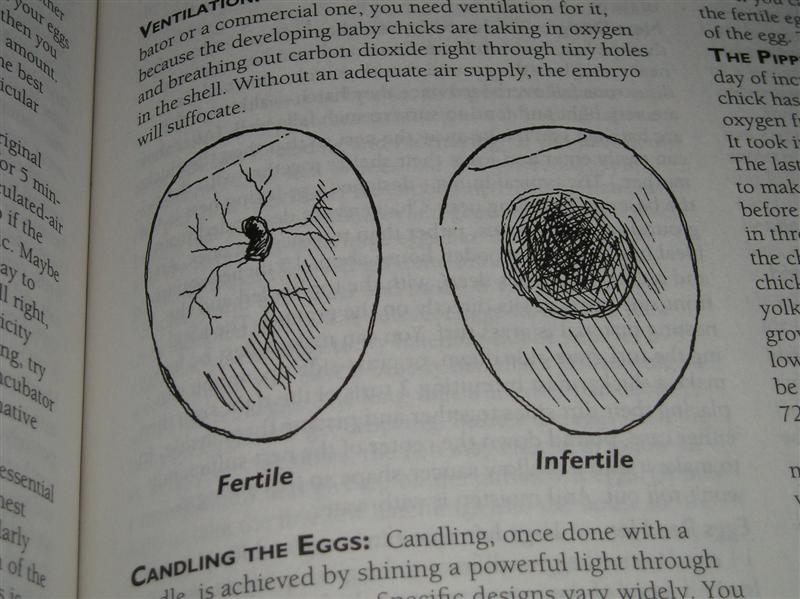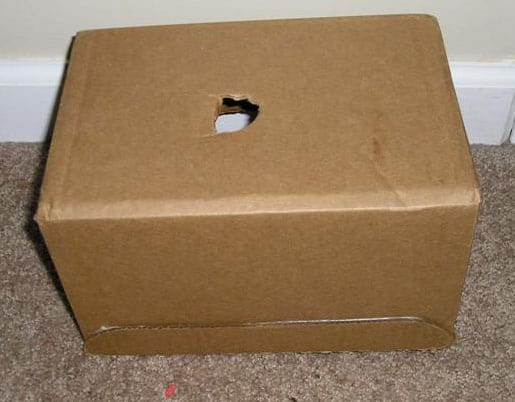When incubating eggs, or when a hen is sitting on a clutch, there is a way to find out whether or not a chick is actually growing in there. This process is called candling.
Long ago, it was actually done using candles, but nowadays there are many different ways to do it. You can buy special egg candling equipment, or simply rig something yourself.
The idea is to shine a very bright light through the eggshell in a dark room, which illuminates the shell, and allows you to see what’s going on inside!
How Does Candling Work?
Candling works by shining a bright light source behind the egg to notice the growth and development of the embryo inside.
This way you can see through the transparent shell and view details inside, including veins, shadows on the eggshell, which can indicate the fertility and developmental stage of the egg. As the embryo grows, these details become more pronounced and visible in stages, allowing you to notice the progress of the fertilized eggs.
Why Should You Candle Eggs?
Candling is crucial for determining which fertilized eggs are developing and which ones might have problems. Candling provides valuable insights that can inform your estimates on hatching rates and help prevent potential issues with bad eggs in the incubator.
By candling your eggs, you can tell the difference between viable and non-viable eggs, make informed decisions about which eggs to continue incubating, which to ditch, and what the probable issues with them are, if any.
Spotting “yolkers” (eggs that were never fertilized to start with), and “early and late quitters” (eggs that stop developing) among your incubating eggs will prevent major problems (like exploding rotten eggs!) and give you a better idea of how many chickens to expect from a clutch.
Candling will always contribute to a more successful hatching process and better flock management overall!
Is Candling Harmful to the Egg or Chick Inside?
No, not usually, as long as you do it right! Candling doesn’t affect the egg or chick inside as long as you minimize the time the eggs are out of the incubator and avoid candling them too often.
Remember that incubating eggs must have the right temperature and humidity levels in order to develop properly and with certainty. Being out of the incubator environment, with its ideal temp and moisture levels, for even a short time can have serious consequences.
Also, care must be taken to avoid getting an egg too hot. Many light sources like flashlights and even certain egg candlers get quite warm when they are left on, and leaving the egg in contact with them or in close proximity can dangerously overheat them.
Additionally, special care should be taken to protect the eggs from contamination during the candling process to ensure the health and safety of the developing embryos.
When Should You Candle an Egg?
You should candle an egg either 6 or 7 days after laying to verify development or at about 14 days in the incubator to check for proper development prior to hatching. However, it’s crucial to avoid candling the eggs repeatedly or too often, as this can potentially cause developmental issues.
Taking an egg in and out of its incubation environment repeatedly, or moving it around too much, is likely to cause significant problems, and remember that every time you touch it there is a risk of contamination which could cause it to fail.
Check your eggs at the right time and only when necessary, and they’ll be fine.
What Are You Looking For When Candling?
When candling chicken eggs, you should look for the presence of “veins” and “blobs,” which signify the development of the chick inside the egg. This visual inspection allows you to both verify and monitor the growth and progress of the tiny little embryo inside.
The veins are a network of blood vessels that are basically invisible for the first couple of days after laying, but will quickly become prominent and easy to see if your light source is bright enough.
Also, later on in development, you want to check for the presence of the air sac, indicated by a slightly darker patch in the lighter, transparent area near the bottom of the shell.
As the embryo grows and develops, it will take up more room and turn the eggshell opaque or shadowed once again. This is normal.
Additionally, especially in the early stages, you should be vigilant for otherwise invisible cracks, as these could indicate potential issues that may affect the viability of the egg.
Do You Need Special Equipment to Candle Eggs?
Disclosure: if you visit an external link in this post and make a purchase, I may earn a commission. Read my full earnings disclosure here.
No, you can candle eggs with nothing more than a flashlight or your smartphone (if it has a light), but using specialized equipment such as an egg candler can make the job quicker, easier, and safer.
An egg candler is a specialized device designed for candling eggs, typically consisting of a strong light source and a holder to secure the egg for inspection while preventing light “leakage” around it. Good ones also have turntables that let you to smoothly and safely rotate the egg when under observation without directly touching it.
Whatever the type, this tool provides better visibility and stability, enhancing the candling process and allowing for more accurate observations.
Wash Your Hands!
Why wash your hands in the first place? Aren’t egg shells impermeable and protecting the embryos inside from infection?
Well, as it turns out eggs are very susceptible to contamination from bacteria and other microorganisms. These unwanted “guests” can easily transfer from your hands onto the eggshell before migrating inside and then potentially harm the developing chick inside.
Sound impossible? It isn’t: eggshells are permeable! And germs aren’t the only threat. Chemicals on your hands, even something like ink, could spell disaster for the poor incubating embryos.
Washing your hands thoroughly with soap and warm water ensures that you’re not introducing any harmful elements to the precious and incredibly fragile life growing within the eggs.
So always remember, cleanliness first! Wash up before you handle and candle; it’s a simple step but vitally important for healthy chick development.

My Experience Candling
Tonight, we candled our 15 eggs. What we used was very basic- a desk lamp and a small box. In the top of the box we cut a hole, just big enough that the egg could barely sit down in it without falling through.
We laid the lamp down on a table, and put the box over the light bulb. With all other lights off, we put each egg, one by one, over the light shining through the hole in the box.

You guys, this is so exciting! It’s almost as good as seeing a sonogram! The light shined through the eggshell, and we saw a little chick growing (and moving) inside! I squealed with excitement when I saw that first little chick moving within its shell.
After 72 hours of incubating, we could easily distinguish between fertile and non-fertile eggs. The good ones had spider-like blood vessels spreading within (see picture above).
For the eggs that were obviously not fertile, we put them on the menu for dinner: they are still safe to eat after being incubated for up to nine days.
I wish we would have candled some of our eggs sooner, though. Some of ours have been incubating for two weeks now, so the chicks are quite developed. Once the chicks are so far along, they appear to be a large dark mass within the shell.
Some of mine moved, so it was easy to tell that a chick was alive in there. But others just looked like an impenetrable dark shadow. I’ve had a very hard time distinguishing between good eggs and bad ones at this stage.
It wouldn’t be such a big deal to just leave them alone and not worry, but the bad ones can rot and actually explode- spreading bad bacteria all over the other eggs, and making a big, stinky mess in the incubator!! So I definitely want to get the infertile ones out.
There are some eggs that I think are bad, but dang, I’d hate to throw one out if it’s actually alive!! I’m gonna have to candle them again and really take a close look to determine whether they are in fact growing or not.

A city girl learning to homestead on an acre of land in the country. Wife and homeschooling mother of four. Enjoying life, and everything that has to do with self sufficient living.

Hi Kendra,
I’m also having such fun candling the eggs of our two broody hens. I just go outside with the flashlight and cup the eggs one by one.
I’m not so happy today, however, as the Marans hen keeps moving her eggs around, they crack, then she eats them. It’s not the end of the world (well, I guess it is for the chick that may have been developing) I know this occurs regularly in the chicken world, but now she’s down to just one. Have you ever had that happen, or do you always use the incubator? This saddens me just sitting here writing this all out. I’ve got her separated from the other hens (there are only 3 females in all), but if this last egg goes the same way, then what does one do with a broody hen? Sigh.
Tammy,
Sorry to hear about your dilemma!! None of my hens have gone broody, and this is our first batch of incubator eggs, so I’m afraid I have no advice for you. Maybe one of my readers will though. Hopefully since it’s the last egg it won’t have anything to crack against and it will make it. That would be terribly frustrating!!
Hey Kendra,
How exciting!!! What kind of chickens are you raising? We have 2 golden comets, a bared rock, and an Ameraucana. We don’t have a rooster, so we won’t be having any chicks…..just lots of eggs!! 🙂
Hey Kendra,
How exciting!!! What kind of chickens are you raising? We have 2 golden comets, a bared rock, and an Ameraucana. We don’t have a rooster, so we won’t be having any chicks…..just lots of eggs!! 🙂
Hey Jill!!
The chicks will be Rhode Island Red/White Leghorn mixes, and some purebred White Leghorns. *Crossing our fingers!*
Hey Kendra,
My husband and I also candle our eggs using a bright flashlight and just our hands. One of us will cup our hand(s) around the end leaving a little circle at the thumb and forefinger, while the other moves the eggs over the light. We usually do this in the evening down at the chicken house after the chickens have tucked themselves in for the night.
I wouldn’t eat an egg that has been in an incubater for 10 days. If you don’t want them to go to waste, cook them up and serve them shell and all back to the chickens. I haven’t had rotten eggs explode on their own under a chicken or in an incubater BUT once I’m sure they aren’t viable and I toss them up against a rock MAN do they ever exlpode with noxious nastiness!!
Here are a few things that I picked up along the way: First, you can look really close on the large end, in the rotten eggs, you’ll be able to see the air sac. A freshly laid egg doesn’t have that sac, it is acquired over days and weeks as the egg shell allows moisture to escape. Second, rotten eggs will typically weigh less than ones with chicks in them. We can usually tell by holding them but you could also use a diet or postal scale. A final test before you crack them open would be to try floating them in water just like you would if you found a cache of unincubated eggs. Remember that a part of the yolk will stay with the chicks up to 24 hours before they hatch b/c they suck the yolk up for that last umpf of energy that they need to break out of the egg so don’t let its appearance fool you into thinking there is no chick. And even rotten eggs will fool you into thinking that there is movement, those darn gasses will cause that yolk to swish and move around when you are candling them. Hope that helps!
Thank you Chantel. That is very helpful!!
We have had great success with candling our eggs. We simply use a flash light and a dark room. My husband holds the egg in his hand and puts the flashlight to one end. This is a great link to see pics and explanations about the various things that can happen to eggs…http://ucanr.org/freepubs/docs/8134.pdf. I just had 2 Peking ducks hatch the day before yesterday and have more to go. We are hatching chickens, ducks, guineas and turkeys. Happy hatching..